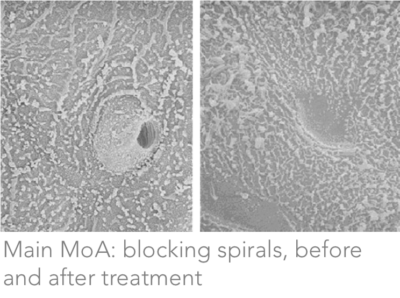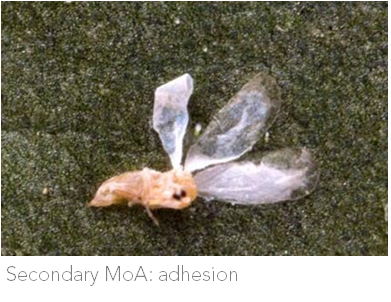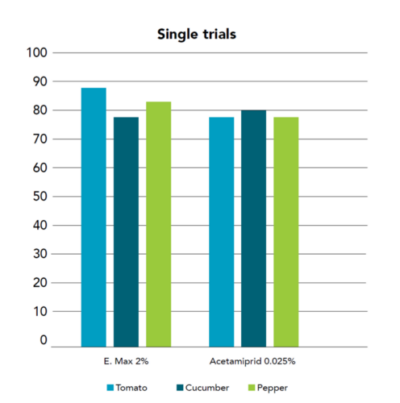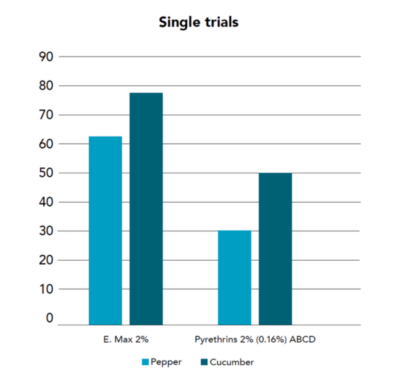VEG INSECTICIDES
BE SURE OF SUPERB VEG CROPS WITHOUT THE USUAL DRAWBACKS
Certis Belchim biopesticides won’t simply give you effective broad-spectrum control. They’ll enable you to:
Introduce your beneficials soon after use and keep them in great shape
Benefit from 0-day PHIs and minimal residues – vital for your retail customers and the food chain
Add valuable alternative MoAs to your IPM programmes for strong resistance management
Protect a wide range of crops, outdoor as well as protected
Reduce virus transmission via aphid vectors
Now discover more.
Why Botanigard
Use Botanigard mainly against whitefly in fully-enclosed veg crops. You may also see side-effect activity on thrips, as well as spider mites, aphids and some beetle species through its contact action.
It’s ideal for ICM and IPM systems, especially where you need to be compliant with low-residue programmes. There’s no harvest interval: Botanigard occurs naturally in the soil.
However, Botanigard comes into its own under high whitefly pressure, when you can use it alongside Eradicoat Max to create an effective IPM programme across the insect lifecycle.


Mode of action
Put simply, Botanigard is a fungus that produces toxins and feeds on the insect.
In more detail, it’s a microbiological insecticide containing 220 g/kg of the entomopathogenic fungus Beauveria bassiana strain GHA, which is particularly aggressive. Unlike bacterial and viral pathogens of insects, Beauveria infects by contact and does not need to be ingested.
Beauveria bassiana is found naturally in soils and occurs as white muscadine disease in insects. When the fungal spores come in contact with the cuticle of susceptible insects, they germinate and grow directly through the cuticle to the inner body of the host. The fungus proliferates throughout the insect’s body, producing toxins, draining the insect of nutrients and eventually killing it.
Once the fungus has killed its host, it grows back out through the softer portions of the cuticle, covering the insect with a layer of white mould (hence ‘white muscadine’). This may take several days under normal conditions. The mould then produces millions of new infective spores (ascospores) that are released to the environment to find the next host.


Proof
Trials show Botanigard to be highly effective against at least one of the key vectors for virus transmission in veg crops.

Easy tank-mixing
You can tank-mix Botanigard with other active ingredients, but need to choose carefully. For the most up-to-date tank-mix sheet, please contact Certis.
When to apply
Timing and dose vary by crop , so consult your advisor. Botanigard WP contains living microorganism, so it’s essential to follow best-practice guidelines – in particular, maintaining viability of the spores prior, during and after use – to maximise efficacy on targets such as whitefly and thrips. Again, your advisor will confirm what is appropriate.

Why Eradicoat Max
Eradicoat Max is designed to make it even easier to control whitefly and spider mites in all crops under permanent protection with full enclosure.
It’s especially suited to fruiting vegetables, such as tomatoes, and helps prevent costly losses caused by these damaging pests. Trials also show that Eradicoat Max provides significant control of aphids in susceptible crops.
A registered crop-protection product, Eradicoat Max is a contact biorational insecticide based on an approved food additive (maltodextrin 476 g/L, 40% w/w). This means there are no residues or MRLs to consider, only the reassurance of more marketable crops. The product is certified for organic use and is highly flexible, too, with a convenient one-day PHI.
Improved efficacy and mixing
Eradicoat Max gives quick knock-down; you’ll see maximum effects within two to four hours of application.
Its advanced soluble concentrate (SL) formulation, however, offers more: it contains adjuvants and thinners that help the active spread across the plant and minimise surface deposits, while anti-foaming agents save time by promoting accurate measuring and speeding up tank-mixing.
Now in 10-litre packs, Eradicoat Max also halves the amount of waste packaging. See how straightforward Eradicoat Max is to use.
Modes of action (MoAs)
Eradicoat Max works in two ways:
The primary mode of action causes suffocation by blocking the insect’s spiracles (small holes in the pest’s cuticle that enable gaseous exchange). Maltodextrin is thought to solidify on contact with pests, making this possible.
The secondary mode of action: in fast drying conditions, maltodextrin adheres to the pest by cross-linking glucose polymers to form an air-impermeable mesh. The effect is like that of sticking wet flour.



IPM compatibility
Eradicoat Max has a strong beneficial profile with low impact. It dries within an hour under glass (this is best practice: the product is most effective under fast drying conditions), allowing you to reintroduce beneficials quickly. In addition, Eradicoat Max aids resistance management: it’s classed in IRAC group UN and has no recorded resistance.

Proof
1. Eradicoat Max (2%) efficacy vs. market standard: efficacy (%) 3DAD on mites (T. urticae) in protected crops:


2. Eradicoat Max (2%) efficacy vs. market standard: efficacy (%) 1DAD on whitefly (Trialeurodes vaporariorum) in protected crops:


Water volume 1,000 L/ha. Trials conducted in SP.
When and how to apply
Apply at the first signs of pest attack. You can make up to 20 applications per crop using a 20 ml/L dose (20 L/ha in 1,000 L water), with three-day spray intervals. A benefit of Eradicoat Max over previous products is its reduced rate, resulting in a lower cost per ha.
As with all crop protection products derived from naturally-occurring substances, use best practice to apply Eradicoat Max for optimum results.
Ensure good coverage and pest contact. Spray to run off. Ensure that the plant is thoroughly covered, paying special attention to the underside of leaves and to growing points. Your advisor and our horticultural team can guide you further.
Use in a programme
Under very high whitefly pressure, you may need to act at every stage in the lifecycle – by combining the complementary activity of Eradicoat Max and Botanigard. In this case only, you may halve the Eradicoat Max dose to 1%.

Why NEMGuard DE
Reduce fanging (or forking) in your carrots and parsnips caused by nematodes. This problem can cut marketable yield and threaten returns by up to £1,000/ha*.
NEMGuard DE non-systemic nematicide controls key nematode species that can affect around 70% of the national carrot and parsnip crop*:
| Common name | Order | Family |
| Free Living Nematode (FLN) | Dorylaimina | Longidoridae |
| Root Lesion Nematodes (RLN) | Tylenchina | Pratylenchidae |
| Root Knot Nematodes (RKN) | Tylenchina | Heteroderidae |
It’s valuable in combination with cover crops in long rotations and with structured representative soil sampling to identify variable nematode populations quickly before drilling.
How NEMGuard DE works
Slow release
NEMGuard DE’s active substances are polysulphides formulated from modified garlic (allium sativum) extract in a DE (Diatomaceous Earth containing fossilised aquatic organisms) granule. This has a honeycomb structure that releases polysulphides immediately on application, spreading a zone of action around the granule. Protection continues for up to six weeks, depending on weather conditions and soil factors.
Continued control
Molecules of NEMGuard DE’s diallyl polysulphides (DAS) penetrate the target organism’s skin.
Once the DAS dissolves through the cuticle of the nematode a process starts with intracellular low molecular weight thiols (LMTs) and protein thiols in the target organism.
This leads to a cascade chain reaction within the nematode that it cannot regulate. The nematode dies due to overwhelming oxidative stress – where the cell desperately tries to negate the effects of the reaction but rapidly runs out of capacity to deal with it.
Proof
Trials show that NEMGuard DE can increase marketable yield by an average 8 t/ha**.
NEMGuard DE trial 2020, parsnips**

Trial of 6 replicates. Variety javelin, location Yorkshire
When and how to use
Apply NEMGuard DE at drilling as an in-furrow treatment as close to the seed as possible.
It requires good, even soil moisture to be fully active, so you need to ensure this during the early stages of crop growth. Ideally:
Apply 20 mm of irrigation post application if no rain is imminent
Ensure at least 80+mm of rainfall and/or irrigation during first 4-6 weeks post application
Best practice:
Don’t use NEMGuard DE on silt soils (the silt affects the active movement of water and uptake of the polysulphides).
Clean the hopper thoroughly at the end of day.
Don’t expose NEMGuard DE to moisture, as this this may affect uniform application.
Application:
Simply make one 20 Kg/ha application per crop.
To avoid extra cost, you can use your existing applicator, rotor and cassettes, with these recommendations:
Use an arrangement of 2 x 4 mm 12 flute stainless steel rotors
Use metering cassettes for older-style Microband H762216 for 2 outlet & H762245 for 3 outlet
For new/current Microband DS metering, use H762300 for 2 outlet & H762306 for 3 outlet
A 2 x 5 mm 12 flute stainless steel rotor option will allow a greater forward speed if needed (at lower speeds or smaller row widths, however, the RPM would be too slow)
Be sure:
If you’re in any doubt, check your set-up with an NSTS engineer. Alternatively, call Certis Belchim on the number below and we’ll put you in the right direction.
*The Vegetable Farmer, September 2021. **Independent parsnip trial vs. untreated, Yorkshire, 2020.
Why Spruzit
Use Spruzit to control biting and sucking pests – spider mites, aphids and caterpillars – in carrots, brassicas and an extensive range of outdoor and fully-enclosed crops.
It’s highly effective, yet allows you to introduce beneficials quickly and safely soon after application. Short persistence and a 0-day harvest interval contribute to bee safety, the flexibility of the product and lower impact on the environment. Together with a novel IRAC class (Group 3 + UNE) and organic approval, this makes Spruzit a strong contender for resistance management in your IPM programme.
Gives Double Defence
Spruzit delivers two hits against pests – one reason why we call it ‘smarter’.
The first active gives quick knock-down, particularly on caterpillars. Natural pyrethrins in chrysanthemum flowers act on sodium channels in the insect’s nervous system.
At the same time, the natural rapeseed oil base has a physical impact; a mixture of triglycerides derived from fatty acids, it blocks the pest’s trachea.
In addition, as you’ll see below, independent bodies show that Spruzit’s oil content helps reduce pest-transmitted viruses

How Spruzit works
Pyrethrins:
- Disrupt sodium channels
Insect nervous system
Rapeseed oil:
- Increases absorption and penetration
- Damages spiracles
- Softens the cuticle
Insect anatomy


Proof
Trials show that Spruzit gives effective broad-spectrum pest control on brassicas and a wide range of outdoor crops.



When to use
Timing and dose rate with Spruzit depend on target pest and crop height, though in general it’s two applications for all crops and four for many. As with all crop protection products derived from naturally-occuring substances, you’ll need to apply Spruzit using best practice to achieve optimum results. Please consult your advisor.

Dose rate
| Pest | Recommended Dose Rate | ||
| 6 L/Ha 600 L/Ha Water (1.0 % concentration) | 9 L/Ha 600 L/Ha Water (1.5 % concentration) | 12 L/Ha 600 L/Ha Water (2.0 % concentration) | |
| Aphids | |||
| Spider mite | |||
| Caterpillars | |||
| Saw flies | |||
| Beetles | |||
| White flies | |||
| Mealy bugs | |||
| Scale insects | |||
| Thrips | |||
Studies show that using a biopesticide containing rapeseed oil, such as Spruzit, can reduce the spread of viruses through aphid vectors and is therefore a significant aid to resistance management.
Why this is important
We all know that insect pests spread damaging, costly viruses in valuable veg crops. In the UK national carrot crop alone, losses are estimated at 15%, worth £20 million in 2015 at farm gate prices. Some emerging threats such as CYLV (carrot yellow leaf virus) can be undetectable during processing, leading to total crop rejection¹.
The peach-potato (or green peach) aphid (Myzus persicae) is a highly efficient virus vector² and can transmit more than 150 types of virus³.
It’s therefore a concern that the peach-potato aphid has multiple resistance mechanisms, while the willow-carrot aphid is becoming resistant to synthetic pyrethroids¹.
How rapeseed oil makes a difference
Some conventional insecticides take time to control pests, allowing viruses to cause damage in vegetable crops. Pyrethrins, one of the active substances in Spruzit, give the necessary fast, thorough knock-down to prevent this. But perhaps more significant is its rapeseed oil base in providing a physical solution – which is why we say it offers ‘Double Defence’.
Field and greenhouse trials comparing rapeseed spray oil with other pesticides against green peach aphid in pepper show high levels of efficacy and persistence, due to the total reduction of newly-deposited white eggs, and that the mode of action suffocates insects and mites, making resistance unlikely².
In addition, modern, non-mineral horticultural oils such as rapeseed oil are less disruptive than conventional insecticides to natural enemies and non-toxic to vertebrates, break down easily in the environment and are generally much safer to use*.
| 1. The Vegetable Farmer, May 2019. |
| 2. Field and greenhouse evaluation of rapeseed spray oil against spider mites, green peach aphid and pear psylla in Serbia: Dejan MARČIĆ, Pantelija PERIĆ, Mirjana PRIJOVIĆ, Irena OGURLIĆ, Institute of Pesticides and Environmental Protection, Laboratory of Applied Entomology, Belgrade, Serbia. |
| 3. A review on aphid-borne virus (Potato Virus Y):Altaf Hussain, Muhammad Arif, Aqleem Abbas, Babar Hussain, Murtaza Ali, Saleem Jaffar, Journal of Entomology and Zoology Studies, quoting Soucke H, Döring TF. Potato virus Y reduction by straw mulch in organic potatoes. Annals of Applied Biology. 2004; 144:347-355 |
| *. [2] quoting Davidson et al., 1991; Agnello et al., 1994; Nicetic et al., 2001; Martin-López et al., 2006. |
Learn more
We’ve plenty of ways to help:
- Talk to your advisor or distributor.
- Read key Eradicoat Max, Spruzit, Botanigard or NEMGuard DE details.
- Sign up to hear from us in the future here.
- Contact our technical experts on 0845 373 0305 or send us this quick form.
